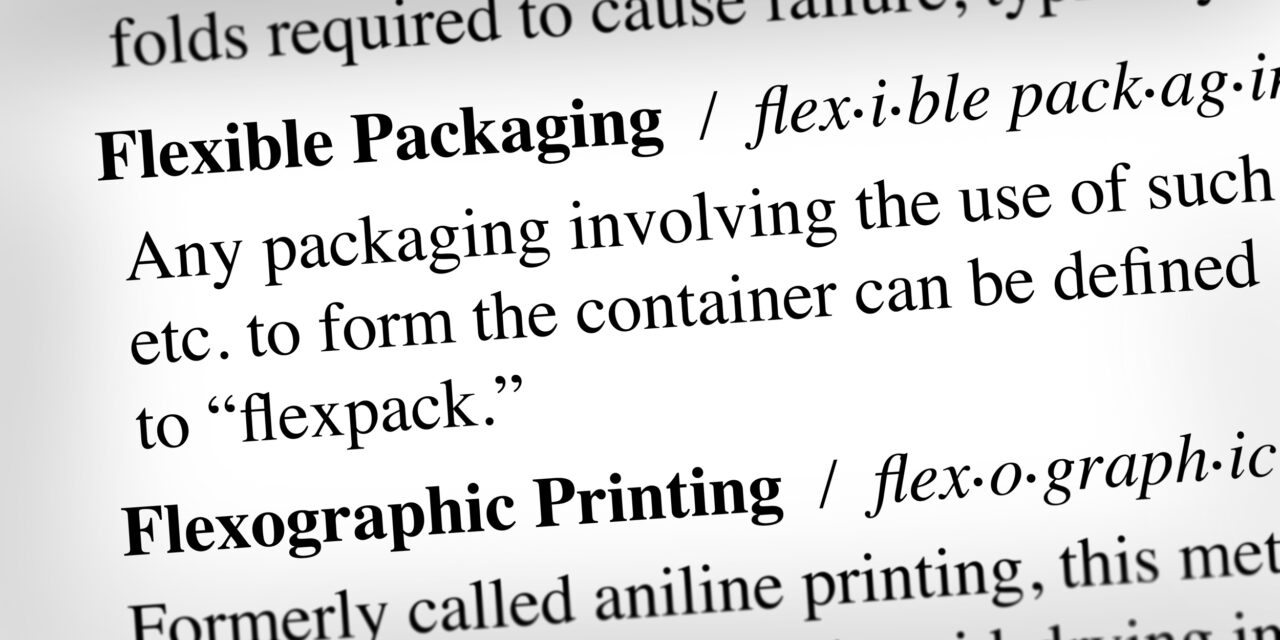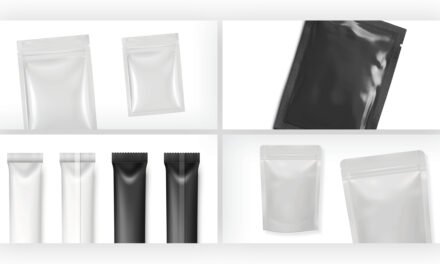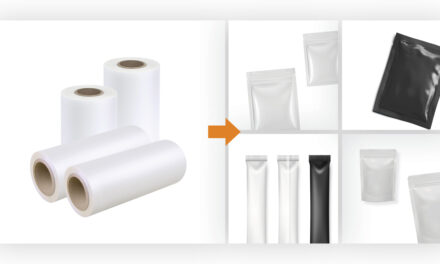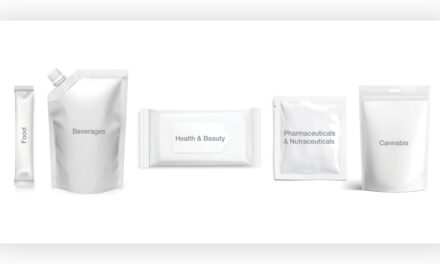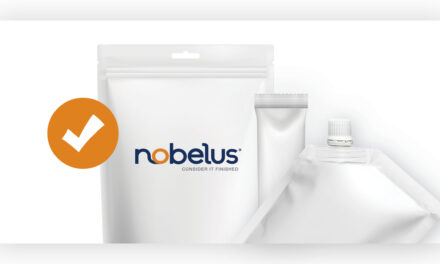A COMPLETE GLOSSARY, PART 1: ESSENTIAL FLEXPACK TERMINOLOGY
Like any industry, flexible packaging has developed its own unique terminology and phrasing borne from decades of growth and specialized knowledge. While much of this information is passed down from one converter to another, the advent of digital printing has enabled more and more people to step into the flexible packaging space from other industries without benefiting from a mentorship. For these flexible packaging newcomers, a deep understanding of the industry’s language and shorthand will be absolutely vital to their long-term success.
With the help of our in-house flexible packaging experts, Nobelus has compiled a glossary of terms that every flexible packaging converter should know to help newcomers establish a solid foundation of knowledge. To learn about different finishes and thermal laminators, take a look at our thermal laminate and equipment glossaries.
FLEXIBLE PACKAGING FOUNDATIONS FROM A TO Z
TIP: To locate a term quickly, press ctrl and F simultaneously and then type the term in the search bar that appears.
BACK HALF
In the flexible packaging industry, back half refers to each step in production from printing the customer’s design to shipping out a finished product. Everything before the project is sent to press is considered the front half of the process.
BUNCH WRAP
Bunch wrapping is the practice of leaving excess material from a wrap gathered on the underside of a package in an irregular manner.
BLISTER PACK
This package is formed from semi-rigid thermoplastic material so that the sheet forms a transparent dome over the packaged product, typically medication or capsule-shaped items.
CLING
Cling, sometimes called drag, describes the adhesion of packaging film to machine surfaces, often as a result of tackiness or static electricity in the film.
COEFFICIENT OF FRICTION (COF)
This is a measurement of how much friction a film will create on a press or laminator. Films with high slip have a low COF, while films with low slip have a high COF and may be more difficult to process.
COLD GLUE
Cold glue is designed to be applied in cold environments. It is particularly helpful for labeling food products that must remain cold, such as bottled beer.
COLD SEAL
This water-based cohesive coating requires only pressure to seal, similar to glues commonly used in crafting.
CONTOUR PACKAGE
Contour packaging is formed from a heated sheet of semi-rigid material that has been shaped by pressure or vacuum force so it follows the contours of the packaged item closely.
CONVENTIONAL INK
Conventional inks are made from pigments dissolved in a vehicle made from resins and solvents. They dry quickly and can prove more versatile than digital inks in certain situations.
CRIMP SEAL
A crimp seal is produced by pressing down on the edge of a package with heated elements that have a serrated surface. This seal provides mechanical rigidity and ensures maximum contact with the film’s surface.
CRIMP-BOTTOM BAG
This flat bag has a crimp-seal bottom, which means there is no fold over. They are usually heat sealed using serrated dies and are not particularly durable.
DEAD FOLD
Dead folds remain in place without being sealed. These folds are seen most commonly in soft lead foils and aluminum foils.
DIGITAL PRINTING
Unlike other printing methods, which rely on the use of plates to transfer ink to the printing surface, a digital press applies ink directly to the printing surface where needed based on the selected design file.
DIMENSIONAL STABILITY
Materials that do not change their size or shape with humidity, heat, or time are said to have dimensional stability.
DOCTOR BLADE
These scrapers regulate the thickness of adhesives or inks on the rollers of a press by removing excess liquid.
DOWNGAUGE
When a thicker film is swapped out for a thinner film for packaging production, the change is called downgauging. The gauge, or thickness, of a film is measured in mil, which represents one thousandth inch.
DROP TEST
Drop tests measure a package’s durability by dropping a filled container from a controlled height using a special device.
DUPLEX BAG
A duplex bag is constructed of two piles of material that are generally spot sealed to each other, typically at the mouth.
ELECTRON BEAM LAMINATION (E-BEAM LAMINATION)
Seen most often in conjunction with digital presses, e-beam lamination uses energy from electrons to instantly cure an adhesive. While this method requires a sizeable equipment investment, its speed, quality, and compatibility with food packaging regulations make it a popular choice.
ELECTRONIC SEALING
This sealing method involves agitating a sheet’s molecular structure with a high-frequency current to generate heat and seal two surfaces together.
ENERGY-CURED SYSTEMS
Energy-cured systems use various types of energy particles to cause a catalytic reaction that hardens or dries a viscous substance, such as an adhesive or ink. UV, LED, and e-beam lamination are all types of energy-cured systems used in flexible packaging.
FIN SEAL
A fin seal is created by bonding the inside edges of two superimposed sheets to create a pouch with a flap of material that rests outside the main package.
FLAT BAG
The simplest form of flexible packaging, a flat bag is a web of material folded into a flat tube with a side or center seam; this tube is then cut off and sealed at one end to enable filling. Flat bags may have a crimped seal or a fold-over seal.
FLAT SEAL
This sealing method uses a flat bar to heat seal thermoplastic films. The bar is pressed down over the unsealed package just long enough to soften the films so their surfaces meld together before cooling and leaving a seal.
FLEX STRENGTH
Flex strength is the ability of a sheet or film to withstand breakage when folded. It can be measured using the folding endurance test, which determines the number of folds required to cause failure, typically through use of a Schopper machine.
FLEXIBLE PACKAGING
Any packaging involving the use of such flexible material as foils, films, paper, etc. to form the container can be defined as flexible packaging. It is often shortened to “flexpack.”
FLEXOGRAPHIC PRINTING
Formerly called aniline printing, this method utilizes rotary letterpress printing via flexible rubber plates and rapid-drying inks. Flexographic presses can produce large volumes of identical prints in a short amount of time and offer superior flexibility for experienced printers.
FOLD-OVER SEAL
This encompasses any seal in which a short section of a package is turned back and sealed in place by heat, adhesives, or a combination of the two.
FRONT HALF
The front half of the flexible packaging manufacturing process involves everything from sourcing films and creating structures to having an initial phone conversation with the customer. Once a project is put on the press, it transitions to the back half of the process.
FRACTIONAL PACKAGING
Perfect for preventing spoilage, fractional packaging involves wrapping units individually so unused portions are protected after the outside package has been opened. The units could be large, as with cereals and rolls of crackers, or they may be small, such as bite-sized chocolates.
GAS PACKAGING
Gas packaging encompasses any gas-tight container in which air has been replaced by a gas, such as carbon dioxide or nitrogen, in a process called off-gassing. The added gases may protect fragile product or aid in preventing spoilage by preventing contact with oxygen.
GUSSETED BAG
Gusseted bags having folds on each side that expand outward when the bag is filled, similar to a bellows. Gussets help a bag maintain its shape, especially when standing.
HEAT SEAL LABEL
Heat seal labels are coated on one side with a heat seal coating, usually a thermoplastic resin.
HEAT SEALING
This term encompasses any sealing method that bonds two or more surfaces by fusing thermoplastic or thermosetting film coatings with precisely controlled temperature, pressure, and time.
HERMETIC SEAL
Hermetic seals prevent air and liquids from leaving or entering a package before it is opened. This seal is extremely common in medical applications.
HOT-STAMPING MACHINE
A hot-stamping machine uses a heated stamp to apply a code mark or date to a package or wrapper.
IMPRINTING INK
Imprinting ink is specially designed to be used with a marking device.
LAMINATE
Lamination is the process of bonding two or more layers of material to create a new structure. Laminates are the result of this process and can range from a simple base material with an adhesive layer to multiple material layers that improve the quality of the overall structure.
LAP SEAL
In contrast to a fin seal, a lap seal closes a package by overlapping the inside edge of the film with the outside edge and sealing them together.
MAKE READY
In the printing industry, this term refers to the process of preparing a press for a run. One crucial step is making sure all printing surfaces are uniform in height.
METALLIZING
This is the process of applying an extremely thin metal coating to a non-metallic surface.
MOISTURE-SET INK
Moisture-set ink is formulated to be stable under normal humidity conditions and then harden when exposed to very high humidity. It’s used often in high-steam environments where sterilization is a concern.
MSI
An abbreviation for thousands of square inches, this is a common unit for pricing films.
MULLEN TEST
The Mullen test is widely used on film packaging materials to determine the package’s relative bursting strength.
OVERPRINT
Overprinting is the practice of printing one layer of ink over another layer in a structure. This can include printing over other inks to achieve a specific color or printing over a laminate layer to accommodate specific design elements.
PACKAGING CONVERTER
This equipment processes raw packaging stock materials into a more advanced state, generally by forming, printing, gluing, laminating, etc.
PEEL SEAL
A peal-seal package is sealed closed with an adhesive that can be easily peeled open by the end consumer.
PEELING BOND
This type of bond occurs when two adhered surfaces can be pulled apart without tearing the fibers, commonly seen with stickers and their release liners.
PLATE
These curved or cylindrical shapes are used on a printing press to transfer ink onto the printed surface in a precise pattern. Each plate bears the design for a specific color to achieve a complete design when combined. They can be made from a variety of materials, from metal to polymers.
PLICATED POUCH
A plicated pouch is a folded pouch that has gussets.
PILLOW BAG
Commonly used for chip packaging, pillow bags are created by sealing a single web into a tube shape and then sealing the top and bottom edges.
PRESS POLISH
A press polish finish is produced by pressing heated metal against a film to create a plastic sheet stock with a high sheen.
PRINTING COMPENSATOR
Also called an eye or registration mark, a printing compensator is a mark printed at regular intervals on a film or substrate. Presses, pouching machines, and slitters can all use this mark to ensure each bag or package is completely identical as it goes through various processes.
RETORTABLE PACKAGING
Retortable packaging is able to withstand the high temperatures of a microwave for the purpose of reheating or cooking the product inside.
REVERSE PRINTING
To protect a printed design from scuffing and abrasions, a printer may choose to reverse print. The design is printed backwards on the inside of a transparent film so that it appears correct when viewed from the other side. This method can reduce costs by making the printing layer and the protective layer one and the same.
SACHET
Sachets are small rectangular or square packages that are used for a wide range of applications, from tea bag packets and pre-portioned spices to sample-sized lotions.
SOLVENT-BASED LAMINATION
Solvent-based lamination uses a solvent as a carrier for the adhesive. This lamination method requires curing time and can react negatively with some materials, limiting its use to certain applications.
SOLVENTLESS LAMINATION
While it requires time to cure, solventless lamination is a highly popular method for a variety of flexible packaging applications. In this method, two compounds are combined to cause a chemical reaction that forms a strong bond between film layers.
SOLVENT SEALING
This method of adhering packaging materials uses small amounts of volatile liquids to soften the coating of the material so it will bond.
SURFACE PRINTING
In contrast to reverse printing, surface printing is performed by printing a design on the outward-facing surface of a film. Surface prints are usually given a layer of protection in the form of a varnish or laminate.
STERILE SEAL
Sterile seals ensure medical supplies remain completely bacteria free prior to opening.
STERILIZABLE
Sterilizable materials can withstand contact with hot steam at 30 pounds of pressure for 30 minutes or contact with dry heat at 200°C (392°F) for 15 minutes.
STAND-UP POUCH
Any pouch that is able to support itself on a flat surface can be categorized as a stand-up pouch. While they vary in size and shape, most stand-up pouches will include a tear-off top seal, and many use a zipper so the end consumer can reclose the pouch after it is opened.
STICK PACK
Stick packs are tall, narrow packets that are typically sealed on the top and bottom. They are frequently used as packaging for individual servings of beverage powders and snack foods like peanuts.
STRIP PACKAGING
Small articles that are packaged individually in a continuous set often use strip packaging. They are typically divided into segments or pockets that can be torn or cut off, as seen with cheese stick snacks or yeast packets.
SUBSTRATE
A substrate is a film or web to which subsequent coatings or layers are added.
TEAR STRENGTH
This is the measurement of the force required to propagate a tear already initiated by a cut on the edge of a material. The Elmendorf tear test measures the weight required to tear one of several layers of notched film.
TEAR STRIP
This narrow ribbon of film is usually incorporated into a wrapper or overwrap during the wrapping operation to help the end consumer open the package. Wrapped boxes and large bags of pet food often employ a tear strip.
TENSILE STRENGTH
Tensile strength measures the resistance of a material to longitudinal tension.
THERMAL LAMINATION
To perform thermal lamination, a laminate with a thermally activated adhesive layer is pulled across heated nip rollers before being pressed against a substrate. Because thermal laminates cure quickly, they enable products to be processed again soon after lamination is complete.
THERMOSETTING INK
Thermosetting ink is formulated to be stable and tack free at ordinary temperatures while setting quickly at elevated temperatures. This enables each ink layer to dry quickly as the package is run through an oven before the next color is applied.
THREE-SIDED SEALED BAG
These bags are typically created from a single web that is folded in half and then sealed at specific intervals to create individual pockets. These pockets are filled with product, sealed at the top, and then separated. They can be used for a wide variety of items and markets.
TRACKING
Film that follows a desired path on a packaging machine without constant adjustment is said to be tracking well.
UNDERFOLD
When wrapping material is folded so the end folds are turned under the bottom of the package and then sealed to the underside, it is called an underfold.
UNSUPPORTED FILM
Referred to simply as “film” in flexible packaging, an unsupported film includes a base material and a finish or coating that gives it unique characteristics, such as a gloss or haptic effect. Unlike a thermal laminate, unsupported films have no adhesive layer, so one must be applied in the lamination process.
VERTICAL FORM FILL SEAL (VFFS)
These machines are capable of shaping flat web into a package, inserting a precise amount of product, and then sealing the package closed in a fully automated process. They can be used to create a range of packaging types, including pillow bags and pouches.
WATER-BASED LAMINATION
Water-based lamination uses water as a carrier for the adhesive that bonds the separate layers together. This method requires time for the laminated films to cure before the new web can be processed.
WAX PAPER
Sometimes called butcher paper, wax paper encompasses all papers that have been impregnated, coated, or otherwise treated with waxes or wax-like materials. It is typically used in packaging for bar soap and stick butter.
WEB
Any thin, flexible material used in the printing and laminating process is called a web. This can include substrates, thermal laminates, unsupported films, foils, and other materials.
WET LAMINATION
Wet lamination is a term that encompasses any lamination method using a viscous adhesive that must be applied and then cured on the press. It contrasts with thermal lamination and self-wound laminates from the prime label industry, which have a pressure-sensitive adhesive.

